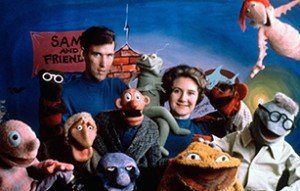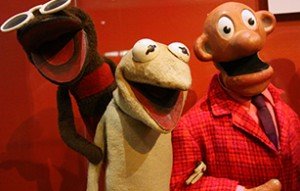Sam and Friends
For those of you who might not have heard of Sam and Friends, Jim Henson’s very first Muppet TV show, I gave a bit of background for it the other day on my post on Jim’s early years, but, to recap, it was an enormously popular local Maryland show that originally ran daily on weeknights for 5 minutes between the 11 PM evening news and The Tonight Show.
The length of the show, as well as the time slot, changed over the course of its 6 years but it remains fascinating today not only because the relatively few remaining fragments of footage we have allow us a glimpse at the early years of the Muppets as well as their evolution, but also because, as old and crackly as that footage may be, it’s truly striking to witness just how much of the Muppet DNA that we know and love today was present from the very beginning, even if in a slightly different form. Kermit was even there, although he wasn’t a frog yet and thus didn’t have his famous collar or flippers, and his voice had more of a Mississippi drawl than he later would.
But if you watch a bunch of these clips in a row, it almost feels like seeing a very early, alternate universe episode of The Muppet Show, sans human guests. It actually had a rather high-minded, artistic concept underlying the zaniness. It was essentially about a friendly, quiet guy named Sam, surrounded by weirdo, abstract characters (none of whom were identifiable as any form in particular, thus Kermit’s non-frog-ness) who would push and encourage him through life with their wacky behavior. Henson’s interpretation was actually that these characters were imaginary–all of them actually various parts of Sam’s psyche. Unfortunately, however, hardly any footage of Sam himself remains in existence. Kermit is much more prominent in all of it, which may also have been how the show naturally developed, as the clips that remain are from later in its run.
Either way, however, this contributes to the vintage-Muppet–Show feel. Like The Muppet Show, it is full of nutty, pun-filled sketches that parody pop culture as well as the television format itself, and it has lots of musical performances, many of which seem to fall apart as the characters continue. The characters also often have a meta awareness that they’re on camera, just as often happens with the later Muppets, particularly in their films.
Another interesting thing is that, as I mentioned previously, in the early days of Sam and Friends, Jim wouldn’t use his own voice for the characters. Instead, he and his partner, Jane–who he eventually married during the show’s run, in 1959–operated the puppets, which would lip sync to records. He considered puppeteering simply a means to an end of pursuing a career in television, not a life’s calling at this point. It was while doing the Wilkins and Wontkins commercials that he began to contribute voices to the characters himself, and then eventually, he finally began to gain confidence and started to do character voices on Sam and Friends as well. Furthermore, a trip around Europe where he witnessed a great deal of puppetry ending up solidifying for him that it was a worthy art form, which reinvigorated his commitment to the Muppets and inspired him to become even more invested in puppet performance, as well as to begin writing some of his own sketches. The set of Sam and Friends sketches I watched contains a combination of both approaches.
“Tick Tock Sick”
The first bit I watched is actually a song that Jim wrote, composed, and performed himself, another indication of his growing artistic confidence, as well as desire to experiment with different forms. He released it as the A-side of a 45 record and might have used it on Sam and Friends, as well, although there is no remaining video evidence of that. It’s a short, jazzy number in which a narrator is being driven slowly crazy by the relentless ticking of a number of clocks. This is actually a recurring theme throughout Henson’s work, particularly in his short film, Time Piece, which we’ll be getting to eventually, and the beautiful, funny, and haunting Muppet Show performance of “Time in a Bottle,” and is indicative of a man who was bursting with thousands upon thousands of creative ideas, only a fraction of which he knew he’d be able to achieve in his lifetime.
Biographer Brian Jay Jones attributes this constant awareness of time as being due at least in part to losing his older brother, Paul, who died young in a car accident in 1956, not long after Sam and Friends began. This number is essentially a comedic one, however, showing Jim’s ability to balance serious topics with humor, with the frustrated narrator eventually throwing out all of his clocks and instead sticking to a silent sundial, which doesn’t constantly remind him of time running away. Jim uses his gruffer voice here, so like Wontkins, the character sounds like an earlier version of Rowlf or Dr. Teeth. You can listen to it here.


